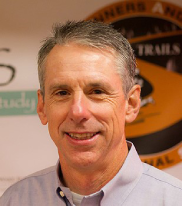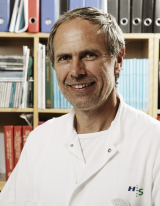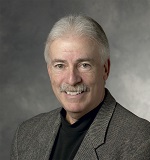2022 Lifetime Achievement Award Winner - Stephen P. Messier, PhD
 Steve Messier is Professor and Director of the J.B Snow Biomechanics Laboratory at Wake Forest University. He has been at Wake Forest for 40 years and has 30 years of experience in clinical trials research specifically related to knee osteoarthritis (OA). He has published over 100 original manuscripts including 20 over the past 5 years.
Steve Messier is Professor and Director of the J.B Snow Biomechanics Laboratory at Wake Forest University. He has been at Wake Forest for 40 years and has 30 years of experience in clinical trials research specifically related to knee osteoarthritis (OA). He has published over 100 original manuscripts including 20 over the past 5 years.
Steve and his OA research team are revered internationally for their work on the effects of exercise and weight loss on gait, strength, function, and pain in knee OA. Steve has led five seminal trials in this area. He was the co-principal investigator of the Fitness Arthritis in Seniors Trial (FAST), which examined aerobic vs. strength training. Steve was principal investigator of the Arthritis Diet and Activity Promotion Trial (ADAPT), which established the efficacy of the combination of diet and exercise. He also led the Intensive Diet and Exercise for Arthritis (IDEA) trial, which showed convincingly that a 10% weight loss combined with moderate exercise results in a 50% reduction in pain in older adults with chronic knee OA. Most recently, Steve and colleagues published the Strength Training for Arthritis Trial (START), which showed that high intensity strength training was not more effective than low intensity strength testing or attention control in reducing pain associated with OA. Each of these trials was funded by National Institutes of Health (NIH); three of four were published in the prestigious Journal of the American Medical Association ( JAMA).
Currently, Steve is principal investigator of the multi-center Weight loss and Exercise for Communities with Arthritis in North Carolina (WE-CAN) trial. WE-CAN recruited 823 overweight and obese older adults with knee OA in three North Carolina communities to determine if the groundbreaking results achieved in the IDEA trial can be translated to real-world community settings. Steve also leads TOPS (The Osteoarthritis Prevention Trial) a proposed multicenter trial to determine if diet and exercise can prevent the development of OA in overweight women at risk. The TOPS team received a NIAMS planning grant to prepare for this trial.
Steve’s publications are widely cited. I list below the lead publications for the FAST, ADAPT, IDEA, and START trials. In secondary papers, Steve and colleagues have demonstrated the impressive effects of these diet and exercise interventions on other outcomes including strength, physical performance, inflammatory biomarkers, and MRI evidence of joint damage.
- Ettinger, W.H., Burns, R., Messier, S.P., Appelgate, W., Rejeski, W.J., Morgan, T. et al. A randomized trial comparing aerobic exercise and resistance exercise to a health education program on physical disability in older people with knee osteoarthritis: The fitness' arthritis' and seniors trial (FAST). JAMA 1997; 227:25-31.
- Messier, SP., Loeser, RF., Miller, GD., Morgan, T., Rejeski, WE., Sevick, MA. Pahor, M., Ettinger, WJ, Williamson, J. Exercise and weight loss in overweight and obese older adults with knee osteoarthritis: the arthritis, diet, and activity promotion trial (ADAPT). Arthritis and Rheumatism 2004; 50:1501-1510.
- Messier, S.P., Mihalko, S.L., Legault, C., Miller, G.D., Nicklas, B.J., DeVita, P., Beavers, D.P., Hunter, D.J., Lyles, M.F., Eckstein, F., Williamson, J.D., Carr, J.J., Guermazi, A., Loeser, R.F. Effects of intensive diet and exercise on knee joint loads, inflammation, and clinical outcomes among overweight and obese adults with knee osteoarthritis: The IDEA randomized clinical trial. JAMA 2013: 310(12):1263-1273.
- Messier, S.P. Mihalko, S.L., Beavers, D.P., Nicklas, B.J., DeVita, P., Carr, J.J., Hunter, D.J., Lyles, Guermazi, A., Bennell, K.L., Loeser, R.F. Effect of high-intensity strength training on knee pain and knee joint compressive forces among adults with knee osteoarthritis. JAMA 2021, 325:646-657.
Steve has supported OARSI wisely, generously, and in many capacities. He was a member of the Board of Directors from 2014 – 2018. He served as Chair of the Fiscal Committee from 2014-2019 and in that role played a pivotal role in reversing several consecutive years of operating losses. With Steve’s firm, wise financial stewardship, OARSI accumulated an enviable balance sheet and substantial reserves, which have been invaluable in buffering financial losses caused by the pandemic. Steve also served on the OARSI Clinical Guidelines Committee in 2014-14, chairing the subcommittee on non-pharmacologic interventions. Finally, Steve has served on the Editorial Board of Osteoarthritis and Cartilage from 2008-present.
Beyond these extraordinary accomplishments, Steve Messier among the most humble, collaborative, dignified, and ethical colleagues I have ever met. His research team at Wake Forest and collaborating institutions has worked productively together for decades, testifying to Steve’s generosity, warmth, and clarity as a scientific leader. The team is highly multidisciplinary consisting of nutritionists, exercise physiologists, biomechanists, pain psychologists, physical therapists, statisticians, epidemiologists, and physicians. Steve regards each member and his or her discipline with utmost respect and encourages interchange across these disciplines. Steve’s leadership style is characterized by humility, active listening, clear communication, and clarity of purpose.
2022 Lifetime Achievement Award Winner - Henning Bliddal, MD, DMSci
 Henning Bliddal has for more than 20 years, with tireless energy, created evidence about the investigation and treatment of osteoarthritis. Henning Bliddal played a crucial role in the foundation (1998) and growth of The Parker Institute – an externally funded rheumatological research institute at Frederiksberg Hospital, Copenhagen, Denmark. Today, Henning Bliddal is the head of the institute that now employs more than 50 people involved in research in various aspects of musculoskeletal diseases with a particular focus on osteoarthritis.
Henning Bliddal has for more than 20 years, with tireless energy, created evidence about the investigation and treatment of osteoarthritis. Henning Bliddal played a crucial role in the foundation (1998) and growth of The Parker Institute – an externally funded rheumatological research institute at Frederiksberg Hospital, Copenhagen, Denmark. Today, Henning Bliddal is the head of the institute that now employs more than 50 people involved in research in various aspects of musculoskeletal diseases with a particular focus on osteoarthritis.
Henning Bliddal was a pioneer in creating awareness of the important role of overweight and obesity in osteoarthritis and has led several of the pivotal studies on weight loss in the area. Henning Bliddal’s work has had an important impact on the current worldwide recommendation of weight loss as a primary management strategy of knee osteoarthritis. Henning has over the years, continuously pursued weight loss and weight maintenance in knee osteoarthritis resulting in several large clinical trials (most of them highly cited). Henning Bliddal has also pioneered the introduction of exercise for knee osteoarthritis leading one of the early randomized trials in the area, which he has continued to explore via sustained support of studies of exercise for osteoarthritis. Henning Bliddal has also studied ultrasound guided intra-articular injection therapies and the role of dietary supplements in osteoarthritis management, including ginger extracts, and rosehip powder. Also, his many clinical studies have always had a basic science angle to them. Therefore, many of his studies have participated in the development and validation of several imaging techniques for osteoarthritis (e.g. ultrasound and MRI), as well as studies in biomechanics, pain mechanisms, and biomarkers of osteoarthritis.
Henning Bliddal's research has always had the patients in the center and it was a natural consequence of his research effort that the Osteoarthritis Outpatients Clinic was established at Frederiksberg Hospital in 2012. The clinic is unique as it exclusively works with the development and implementation of non-surgical treatments for osteoarthritis. The outpatient clinic runs its own “osteoarthritis school” with diet education for overweight and obese patients with osteoarthritis, where the results of Henning Bliddal's research efforts are translated directly into patient treatment. Henning Bliddal’s research has also helped to get knee osteoarthritis recognized as a comorbidity to obesity, and the Danish Pharmaceutical company Novo Nordisk’s anti-obesity drug, liraglutide, and the ongoing test of the new GLP-1 analogue, semaglutide, in an osteoarthritis context, is largely based on Henning Bliddal's research.
Based on clinical research, Henning Bliddal has an extensive scientific production with at the time of writing this nomination 446 publications on PubMed, of which many pertain to osteoarthritis. From his publication record it is clear that Henning Bliddal has a strong international presence and has participated in several international projects and collaborations. Henning Bliddal has consistently mentored trainees in the institute and has supervised more than 40 PhD students and several post docs over the years and left his mark on the future of osteoarthritis research in both Denmark and abroad. It is no coincidence that several leading academics in the field are Henning Bliddal's former PhD students, including professors in rheumatological ultrasound diagnostics, physiotherapy, occupational therapy, biostatistics, and musculoskeletal radiology – all now engaged and focused on the study of both basic and clinical aspects of osteoarthritis.
Despite his age of 69 years, Henning Bliddal is behind several ongoing large projects that will shed further light on osteoarthritis in the coming years, e.g. with large research projects that aim to clarify the possible significance of inflammation and crystal formation in the development of knee and hand osteoarthritis. With his usual eye on the benefits of patients, Henning Bliddal has crafted randomized trials of non-surgical (weight loss) versus surgical treatment of knee osteoarthritis, and for hand osteoarthritis a test of medical treatment against crystal-induced inflammation. The projects also involve an effort to increase awareness in general practice of the problems of hand osteoarthritis and the development of tools for counselling and treatment.
Patients have always been at the center of Henning Bliddal and the Parker Institute, where there has been patient involvement in research from the very beginning. Immediately after his appointment as professor at Copenhagen University, Henning Bliddal formed a local patient association, whose several hundred members over the years have helped to secure the patients' perspectives in all research projects. The association arranges informative annual meetings about the research with up to 1000 attendees. In 2018 Henning Bliddal established the Frederiksberg cohort, a 10-year study in which people at risk of osteoarthritis, the then 10,000, 60-69-year-old citizens in Frederiksberg Municipality, participate in an annual survey on their use of treatments, including alternative methods to provide better health for their knees. It is natural in Henning Bliddal’s universe that all patients in the Osteoarthritis Outpatients Clinic are followed up regularly with patient-reported outcomes, which provides opportunities for the introduction of value-based health care as a result of the treatments – an issue close to Henning Bliddal’s heart.
Professor Henning Bliddal is still an active participant and supporter of OARSI.
2021 Lifetime Achievement Award Winner - Alan J. Grodzinsky
 Alan Grodzinsky, ScD, is the Director of MIT’s Center for Biomedical Engineering, and is Professor of Biological, Electrical, and Mechanical Engineering in the Departments of Biological Engineering, Electrical Engineering and Computer Science, and Mechanical Engineering at MIT. His research interests center on osteoarthritis and degenerative joint disease; complex microphysiological organ-on-a-chip systems for drug discovery and drug delivery for osteoarthritis; tissue engineering for cartilage repair; cellular mechanotransduction; and molecular, cellular and tissue nanomechanics. He has published over 350 refereed journal articles and reviews in these fields. While his undergraduate and graduate training at MIT was originally in Electrical Engineering and Computer Science, he is a founding faculty member of MIT’s Biological Engineering Department.
Alan Grodzinsky, ScD, is the Director of MIT’s Center for Biomedical Engineering, and is Professor of Biological, Electrical, and Mechanical Engineering in the Departments of Biological Engineering, Electrical Engineering and Computer Science, and Mechanical Engineering at MIT. His research interests center on osteoarthritis and degenerative joint disease; complex microphysiological organ-on-a-chip systems for drug discovery and drug delivery for osteoarthritis; tissue engineering for cartilage repair; cellular mechanotransduction; and molecular, cellular and tissue nanomechanics. He has published over 350 refereed journal articles and reviews in these fields. While his undergraduate and graduate training at MIT was originally in Electrical Engineering and Computer Science, he is a founding faculty member of MIT’s Biological Engineering Department.
At MIT, Al developed two required graduate courses in Biological Engineering Department and published a textbook on these subjects titled Fields, Forces and Flows in Biological Systems (Garland Science, 2011). The topics in this book were motivated in part by the challenges of understanding the transport properties and biomechanical behavior of connective tissues such as cartilage, tendons and ligaments. His research in the 1980s was focused on these topics, but then evolved in the 1990s into the study of cartilage mechanobiology at the tissue, cell and molecular levels, using in vitro explant organ culture systems. These studies naturally led to a focus on tissue engineering for cartilage repair in the 2000s. Given the crucial importance of the extracellular matrix (ECM), Al and his group at MIT then developed AFM-based nanoindentation technologies that were applied to tissues, cells and networks of matrix molecules, such as aggrecan, to quantify their contribution to cartilage stiffness and permeability at the molecular scale. Recent studies these past years have demonstrated the ability of cationic nanoparticles to provide sustained delivery of therapeutics inside cartilage for OA/PTOA.
Al has received numerous awards for these studies including the NIH MERIT Award (for research on Cartilage Mechanobiology), the Melville Medal of the American Society of Mechanical Engineering (for molecular electromechanical models of aggrecan’s contribution to cartilage stiffness), the Kappa Delta Prize of the American Academy of Orthopaedic Surgeons, the Borelli Award of the American Society of Biomechanics, the Outstanding Achievement in Mentoring Award of the Orthopaedic Research Society (ORS), and the Distinguished Investigator Award of the ORS and the American Academy of Orthopaedic Surgeons’ Orthopaedic Research and Education Foundation.
Al was elected Founding Fellow of the American Institute of Medical and Biological Engineering, and is past Chair of the Gordon Research Conference on Musculoskeletal Biology and Bioengineering. He is past President of the Orthopaedic Research Society, the International Cartilage Repair Society, and the Society for Physical Regulation in Biology and Medicine. He has been on the Editorial Boards of Journal of Orthopaedic Research, Polymer Networks and Gels, Arthritis & Rheumatology, Biophysical Journal, and he continues on the board of Osteoarthritis and Cartilage. He has consulted for numerous industrial and academic institutions, and federal agencies including the NIH, NSF, FDA, and the Department of Justice, and he has received Honorary Doctorates from the University of Montreal and University of Eastern Finland (Applied Physics). Al’s most recent research involves an organ-on-a-chip model incorporating co-culture of normal human knee osteochondral plugs and synovium explants to study post-traumatic osteoarthritis progression, drug discovery and drug delivery, launched on SpaceX-21 to the International Space Station this past December, 2021.
2020 Lifetime Achievement Award Winner - Tom Andriacchi
 I am pleased to share this summary of Dr. Tom Andriacchi’ s career. It is interesting to see how his perception of OA evolved over more than 40 years of research. Recognizing that OA involves multiple organ systems at scales from the whole body to the molecule has sent him on a continually evolving journey to incorporate and learn new disciplines. While incorporating new disciplines was challenging it had a major impact on his research career. The following illustrates several examples of challenges he encountered over the span of his research career. Tom hopes these examples will help young investigators to recognize that evolving research views to address unexpected results can be challenging but often leads to new opportunities to study the complexity of OA.
I am pleased to share this summary of Dr. Tom Andriacchi’ s career. It is interesting to see how his perception of OA evolved over more than 40 years of research. Recognizing that OA involves multiple organ systems at scales from the whole body to the molecule has sent him on a continually evolving journey to incorporate and learn new disciplines. While incorporating new disciplines was challenging it had a major impact on his research career. The following illustrates several examples of challenges he encountered over the span of his research career. Tom hopes these examples will help young investigators to recognize that evolving research views to address unexpected results can be challenging but often leads to new opportunities to study the complexity of OA.
Tom’s first challenge occurred (≈1974) as a post-doctoral fellow while he was studying total joint replacement. At that time there were frequent mechanical failures of hip and knee replacement. This problem seemed well suited for a mechanical engineer since it involved engineering materials (metal and plastic). However, he found it was wrong to assume this was purely an engineering problem. He recognized the need to understand how joint design influenced patient function and conversely how patient function influenced the mechanical demands on the joint. Tom realized he needed to change his approach and study the gait of patients with joint replacement. While this change required him to develop and learn new methods for gait analysis, the insight from these gait studies produced information that helped to improve design criteria and outcomes of total joint replacement.
The next impactful challenge he faced was trying to interpret the unexpected finding that ambulatory mechanics could influence the clinical pathogenesis and progression of knee OA. This started with a study of the high tibial osteotomy (HTO) for medial knee OA. That study showed it was clinically beneficial for patients with knee OA to have lower dynamic load at the knee (knee adduction moment or KAM) during gait. This finding had a substantial impact that led to numerous gait studies of OA as well as interventions to modify gait to lower the KAM. One intervention from Tom’s lab included a low-cost shoe that was shown to reduce the KAM and knee pain in a clinical trial.
The HTO study led to one of the most pivotal and challenging findings in his career. Specifically, his lab found that gait mechanics could be associated with prospective changes in cartilage morphology and influenced changes in serum biomarkers. The challenge here was that these studies required integrating diverse disciplines into his research protocols. A key outcome from these studies was that biomarker sensitivity to OA could be increased using walking as a mechanical stimulus. This outcome led to developing an “OA stress test” that involved testing for changes in OA biomarkers that resulted from walking on treadmill. The OA stress test produced evidence that mechanically stimulated biomarker changes could be associated with prospective cartilage changes.
The current challenge (still evolving) is to gain a better understanding of the interaction among the multiple signaling pathways from the scale of the whole-body mechanics to the molecule that influence OA. While his perspective has continued to evolve to include biological and morphological elements associated with OA, he remains a mechanical engineer. As such, it has become clear to him that the impact of mechanics has not been well integrated with biological and structural elements. To this end he introduced a new term “mechanokines” as mechanical signals to be considered with cytokines in a manner that integrates mechanics into the biological and morphological studies of OA. Finally, after looking back over 40 years of studying OA, he acknowledges his career reflects the meaning of a quote from Albert Einstein “It is not that I'm so smart. But I stay with the questions much longer.”
